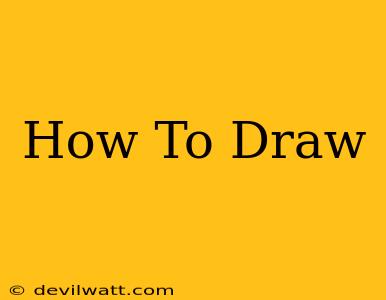So you want to learn how to draw? That's fantastic! Drawing is a rewarding skill that can be enjoyed by anyone, regardless of age or prior experience. This guide will walk you through the basics, providing you with the foundational knowledge and techniques to start your artistic journey. Whether you dream of sketching realistic portraits or creating whimsical cartoons, this comprehensive guide will equip you with the tools and confidence to begin.
Getting Started: Essential Materials
Before you dive into the creative process, you'll need a few essential materials. Don't feel pressured to buy the most expensive items right away; affordable options are perfectly suitable for beginners.
What you'll need:
- Pencils: A variety of pencils with different grades (e.g., 2H, HB, 2B, 4B) will allow you to achieve different levels of darkness and detail. Start with a HB pencil for general sketching.
- Eraser: A good quality eraser is crucial for correcting mistakes and refining your drawings. A kneaded eraser is particularly useful for lifting graphite without damaging the paper.
- Drawing Paper: Choose a paper specifically designed for drawing. Smooth paper is good for detailed work, while textured paper provides a more expressive look.
- Sharpener: Keep your pencils sharp for precise lines and details. A quality sharpener will make a significant difference.
- Optional extras: A sketchbook to keep your drawings organized, blending stumps for smoother shading, and a ruler for straight lines.
Fundamental Drawing Techniques
Mastering these basic techniques will lay the groundwork for more advanced drawing skills.
1. Basic Shapes and Forms:
Learning to see the world in terms of basic shapes (circles, squares, triangles) is key. Practice drawing these shapes repeatedly, focusing on accurate proportions and smooth lines. This helps you build a strong foundation for depicting more complex objects.
2. Shading and Value:
Shading creates depth and dimension in your drawings. Practice using different shading techniques such as hatching, cross-hatching, and blending to achieve different levels of darkness and texture. Observe how light falls on objects and replicate that in your drawing.
3. Perspective:
Understanding perspective is essential for creating realistic and believable scenes. Start by learning about one-point and two-point perspective to accurately represent depth and space on a flat surface.
4. Proportion and Anatomy:
Accurate proportions are crucial, especially when drawing people or animals. Use simple guidelines and measurements to ensure that your subject's features are in the correct ratio to one another. Learning basic anatomy can be helpful for depicting realistic forms.
Practice Makes Perfect: Tips for Improvement
Consistent practice is the most effective way to improve your drawing skills.
- Draw regularly: Even short, daily drawing sessions are more beneficial than infrequent long ones.
- Start with simple subjects: Don't try to tackle complex subjects right away. Begin with simple objects and gradually work your way up to more challenging ones.
- Study other artists: Analyze the work of artists you admire. Pay attention to their techniques, style, and use of light and shadow.
- Don't be afraid to make mistakes: Mistakes are part of the learning process. Embrace them and learn from them.
- Seek feedback: Share your drawings with others and ask for constructive criticism.
Expanding Your Skills: Exploring Different Styles
Once you've mastered the basics, explore different drawing styles to discover your own unique artistic voice. Experiment with:
- Sketching: Quick, expressive drawings that capture the essence of a subject.
- Cross-hatching: Using intersecting lines to create shading and texture.
- Stippling: Creating shading using dots of varying density.
- Cartooning: Creating stylized and often humorous characters and scenes.
- Realistic drawing: Focusing on accurate representation of form, light, and shadow.
Learning how to draw is a journey, not a destination. Embrace the process, be patient with yourself, and most importantly, have fun! With consistent effort and dedication, you'll be amazed at the progress you make. So grab your pencils, find your inspiration, and unleash your inner artist!

